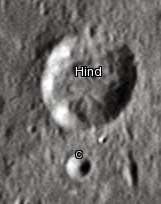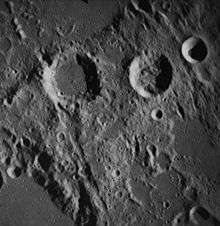Hind (crater)
Hind is a lunar impact crater that lies to the southeast of the walled plain Hipparchus, and due east of the crater Halley. Its diameter is 29 km. It was named after British astronomer John Russell Hind.[1] The rim of Hind is relatively free of wear and distortion, except for a break at the north rim. The floor of Hind is relatively uneven, however, compared to the interior of Halley. Hind and the craters Hipparchus C and Hipparchus L form a line with diminishing diameters that point to the northeast.
 Apollo 16 image | |
| Coordinates | 7.9°S 7.4°E |
|---|---|
| Diameter | 29 km |
| Depth | 3.0 km |
| Colongitude | 353° at sunrise |
| Eponym | John R. Hind |
Satellite craters

Hind crater and its satellite craters taken from Earth in 2012 at the University of Hertfordshire's Bayfordbury Observatory with the telescopes Meade LX200 14" and Lumenera Skynyx 2-1
By convention these features are identified on lunar maps by placing the letter on the side of the crater midpoint that is closest to Hind.
| Hind | Latitude | Longitude | Diameter |
|---|---|---|---|
| C | 8.7° S | 7.4° E | 7 km |
gollark: The best you can do for BIOS-destroying is just crashing its coroutine manager and running a different one.
gollark: ... wow.
gollark: Though admittedly not well. The sandbox is *slightly* broken in areas and may contain gravel.
gollark: PotatOS "works" much "better" than "that".
gollark: That sounds really "secure".
References
- "Hind (crater)". Gazetteer of Planetary Nomenclature. USGS Astrogeology Research Program.
- Andersson, L. E.; Whitaker, E. A. (1982). NASA Catalogue of Lunar Nomenclature. NASA RP-1097.CS1 maint: ref=harv (link)
- Bussey, B.; Spudis, P. (2004). The Clementine Atlas of the Moon. New York: Cambridge University Press. ISBN 978-0-521-81528-4.CS1 maint: ref=harv (link)
- Cocks, Elijah E.; Cocks, Josiah C. (1995). Who's Who on the Moon: A Biographical Dictionary of Lunar Nomenclature. Tudor Publishers. ISBN 978-0-936389-27-1.CS1 maint: ref=harv (link)
- McDowell, Jonathan (July 15, 2007). "Lunar Nomenclature". Jonathan's Space Report. Retrieved 2007-10-24.CS1 maint: ref=harv (link)
- Menzel, D. H.; Minnaert, M.; Levin, B.; Dollfus, A.; Bell, B. (1971). "Report on Lunar Nomenclature by the Working Group of Commission 17 of the IAU". Space Science Reviews. 12 (2): 136–186. Bibcode:1971SSRv...12..136M. doi:10.1007/BF00171763.CS1 maint: ref=harv (link)
- Moore, Patrick (2001). On the Moon. Sterling Publishing Co. ISBN 978-0-304-35469-6.CS1 maint: ref=harv (link)
- Price, Fred W. (1988). The Moon Observer's Handbook. Cambridge University Press. ISBN 978-0-521-33500-3.CS1 maint: ref=harv (link)
- Rükl, Antonín (1990). Atlas of the Moon. Kalmbach Books. ISBN 978-0-913135-17-4.CS1 maint: ref=harv (link)
- Webb, Rev. T. W. (1962). Celestial Objects for Common Telescopes (6th revised ed.). Dover. ISBN 978-0-486-20917-3.CS1 maint: ref=harv (link)
- Whitaker, Ewen A. (1999). Mapping and Naming the Moon. Cambridge University Press. ISBN 978-0-521-62248-6.CS1 maint: ref=harv (link)
- Wlasuk, Peter T. (2000). Observing the Moon. Springer. ISBN 978-1-85233-193-1.CS1 maint: ref=harv (link)
External links
| Wikimedia Commons has media related to Hind (crater). |
- Hind at The Moon Wiki
- Wood, Chuck (May 27, 2007). "Drawings". Lunar Photo of the Day. Archived from the original on June 14, 2011. - includes Hind crater
This article is issued from Wikipedia. The text is licensed under Creative Commons - Attribution - Sharealike. Additional terms may apply for the media files.
